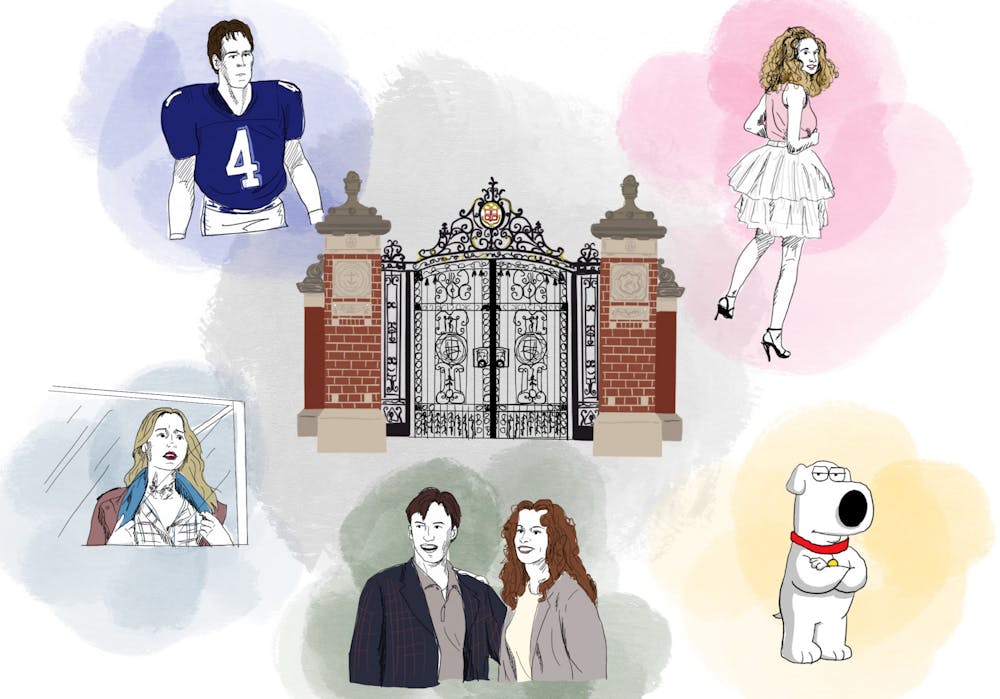What do Brian Griffin from “Family Guy,” Carrie Bradshaw from “Sex and the City,” Cliff Calley from “West Wing” and Andrea Sachs from “The Devil Wears Prada” all have in common? They all walked through the Van Wickle Gates. The Herald spoke to authors and screenwriters whose characters attended Brown to learn how the University’s name has been evoked in popular culture.
Among its peer institutions, Brown is noted for its culture of campus activism and commitment to academic and intellectual freedom with its unique features such as the Open Curriculum and shopping period. Over the course of the history of the University, Brown has been described as the progressive, hip and creative Ivy, and it has been the location of many works in popular culture from novels to television to films.
Brown in the novel
When Jeffrey Eugenides ’82 wrote his 2011 novel “The Marriage Plot,” he wanted to see how the 19th century trope of a marriage plot — the type of story that centers around a couple and potential obstacles on their way to marriage — “might function under contemporary mores,” Eugenides wrote in an email to The Herald.
“The Marriage Plot” focuses on three college friends from Brown University — Madeleine Hanna, Leonard Bankhead and Mitchell Grammaticus — in their senior year in 1982 and their first year post-graduation.
While his novel didn’t have to take place at Brown, he wanted it to be some place “like Brown,” Eugenides said — a “small, liberal arts school caught up in the craze for French theory.”
While he doesn’t think Brown is a more compelling setting for a novel than any other school, he reasoned that “avoiding trouble was reason enough” since he is familiar with life at the University.
Cecily von Ziegesar, the author of the critically acclaimed “Gossip Girl” series, had a different reason for including Brown in her work.
“It seemed like a likely place for a ‘Gossip Girl’ character to go,” von Ziegesar wrote in an email to The Herald. “Brown has a certain cache.”
“Gossip Girl” follows the lives and romances of the privileged socialite teenagers at the Constance Billard School for Girls, an elite private school in New York City’s Upper East Side. It specifically focuses on best friends Blair Waldorf and Serena van der Woodsen whose lives were shared with the public via the eponymous gossip blogger.
Von Ziegesar worked as an editor for a company that produced young adult book series and noticed that “all of their series took place in fictional suburban towns.” Growing up in New York City, her “high school experience was very different.” She noticed that the Upper East Side’s Manhattan private school experience hadn’t been explored and that there were opportunities for humor.
“It was a world I felt like I knew well, as an insider and an observer,” she wrote.
At the time of writing, von Ziegesar’s husband’s boss, her agent and a wealthy classmate of hers had all attended Brown. She specifically noted an instance where she spent a weekend at her friend’s country house in 9th grade where she met her sister’s boyfriend, also a Brown alum, which further shaped her interest in the University.
“He was English and so insanely handsome. He taught me where to put the finger bowl after I’d used it: ‘On the left, Ces.’ I think that must have made a huge impression on me,” she wrote.
In the novel, she decided that Eric would attend Brown as he seemed like someone “who would want to go to a school with a good reputation, but he wouldn’t be competitive about grades.” In von Ziegesar’s experience, the more academically competitive girls, such as Blair, would want to go to Yale.
Brown in television
While von Ziegesar didn’t write the television adaptation of her series, she agrees with the direction in which the show had taken the characters. In the television series, the parents of the characters had a much larger role than they did in the books, and it is noted that Lily van der Woodsen, Serena’s mother, attended Brown. In the show, Serena, rather than Eric, applies and is accepted to Brown, but ultimately does not attend. Serena is also incidentally based on a classmate of hers that went to the Rhode Island School of Design.
“Serena — in the books and the show — is a bit lost. She’s finding herself and she chooses a different path,” she wrote.
Stephanie Savage, one of the co-show runners of the “Gossip Girl” series noted how the decision for Lily van der Woodsen to attend Brown was inspired by a 1998 Vanity Fair article about Brown entitled “School for Glamour.” The article highlighted Brown’s status as “the Ivy’s hottest school” and the types of students that went there.
“It felt like Lily would fit right in with the crowd — with the children of actors and activists, Wall Street barons and actual Barons,” Savage wrote in an email to The Herald.
Savage also worked with Josh Schwartz in the television series “The O.C.” The idea for the show came out of an initial conversation Schwartz had with Savage about centering a series around Orange County. As someone from the East Coast who attended the University of Southern California, where many students came from Orange County, he “felt like (he) had some things to say about that world and experience,” Schwartz wrote in an email to The Herald.
As a Providence native, Schwartz grew up a few blocks away from Brown and “always loved the campus and the ethos of the school.”
Growing up, he added, he thought “the students (he) saw were the height of sophistication and were just impossibly cool.” His interest and familiarity with Brown led him to feature the University in “The O.C.”
“The O.C.” follows a group of teenagers as they navigate high school, growing up, and relationships in Orange County, California. In the series, characters Seth Cohen and Summer Roberts applied to Brown.
He didn’t have both of the characters attend the school as a twist — though Seth seemed to be the obvious choice to be accepted, only Summer, “who was the O.C. equivalent of a Valley girl for much of the show’s run to that point,” is accepted and ultimately attends Brown.
“There was good drama to be had in Summer being accepted and Seth having his heart doubly broken,” wrote Schwartz.
Ian Maxtone-Graham ’81, a television writer and producer, also wanted to pay tribute to Brown, especially because he attended the school. In “The Simpsons” episode “Lisa Gets an A,” he got his opportunity.
The main premise for the episode follows Lisa Simpson cheating on a test and ultimately feeling bad about it, originally an idea from current “Family Guy” showrunner Rich Appel, who was another writer on the staff. Maxtone-Graham and the writers shaped the storyline to follow Lisa getting sick and addicted to video games, consequently resulting in her not wanting to go back to school and neglecting her studies.
The writing team wanted her to panic and worry that she wouldn’t get into Harvard if she failed the test and then have to go to Brown — a lesser school in her mind — instead. Ultimately in the series, Lisa attends Harvard and then Yale.
“I chose Brown because I went there, and I felt like the school could take a joke,” Maxtone-Graham wrote in an email to The Herald.
Brown in film
Ron Bass, the screenwriter behind the 1997 romantic comedy “My Best Friend’s Wedding,” saw an opportunity to credit the University while writing the film.
The story follows a woman who realizes she is in love with her best friend when he decides to marry someone else. In the film, the two protagonists Julianne Potter and Michael O’Neal are friends from their time at Brown.
Bass, who has degrees from Stanford, Yale and Harvard, noted that Brown was not a name that he had heard as often in film, and wanted to change that.
“Just made a momentary decision to give a fine school the credit I could — not that mention in a film means anything, it was just what I wanted to do,” Bass wrote in an email to The Herald.
With dozens of fictional alumni among its ranks, and thousands of real-life applicants continuing to apply each year, Brown has made its mark on the cultural landscape.
Correction: A previous version of this story contained misspellings of the name of Cecily von Ziegesar after first mention. The Herald regrets the error.

Rebecca Carcieri is an arts & culture editor. She is a senior from Warwick, Rhode Island studying political science.





